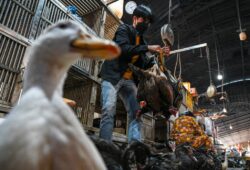The father of a young girl who died of avian flu has since tested positive for the virus (Picture: AFP)
The World Health Organization (WHO) has said it is ‘worried’ about bird flu after two confirmed cases of the H521 variant in humans.
Dr Sylvie Briand, the director of epidemic and pandemic preparedness and prevention, told reporters in a briefing today the UN agency is working with Cambodian authorities amid the outbreak.
She said: ‘The global H5N1 situation is worrying given the wide spread of the virus in birds around the world and the increasing reports of cases in mammals including humans.
‘WHO takes the risk from this virus seriously and urges heightened vigilance from all countries.’
The UN health agency stressed, however, that it’s unclear whether human-to-human transmission is even possible (Picture: Reuters)
Health experts are on the alert after an 11-year-old girl in Cambodia died after being infected by a strain of avian influenza, commonly known as bird flu.
The government said it is the first known human infection of the strain in Cambodia since 2014.
The girl from the Prey Veng province just east of the capital, Phnom Penh, was diagnosed with bird flu after suffering a high fever on February 16.
Health minister Mam Bunhen said the child’s health declined and she was transferred to a children’s hospital in Phnom Penh but died on Wednesday.
The authorities are now testing a dozen of the girl’s contacts for the virus.
Her father, who had been showing symptoms, has also since tested positive.
Briand, however, stressed that it isn’t completely clear whether human-to-human transmission is possible.
Tens of millions of birds have been culled (Picture: AFP)
Instead, she pointed out that the father and daughter might have experienced the ‘same environmental conditions’, such as close contact with infected birds.
Bird flu is a highly contagious and deadly virus that preys on birds such as chickens, turkeys and ducks.
It leaps from bird to bird through nasal secretions, saliva and droppings.
In birds, symptoms of the flu include a drop in egg production, eating less than usual, lethargy and breathing difficulties. At its worst, it can cause complete paralysis, swelling around the eyes and twisting of the head.
The highly pathogenic H5N1 strain spread has into new corners of the globe since last year, with the UK seeing bare supermarket egg shelves and chilling scenes of dead swans.
Across the UK and the EU, more than 48 million birds were culled in an attempt to curb new infections from October 2021 to September 2022, according to an EU report.
More: News
Health experts, however, have long stressed the risk of bird flu for humans is very low.
While it’s not impossible for a human to become infected, it’s very rare.
There have been more than 450 bird flu cases in humans since 2003, according to the WHO.
The death rate for humans with H5N1 is ‘over 50%’, Briand added.
This new strain at the centre of the outbreak has taken an unusually heavy toll on wild birds and even spilt into other mammals, such as minks and bears.
The World Organization for Animal Health says that the typical ‘peak’ of bird flu spreading tends to be in February.
Get in touch with our news team by emailing us at webnews@metro.co.uk.
For more stories like this, check our news page.
Her father has since tested positive.





